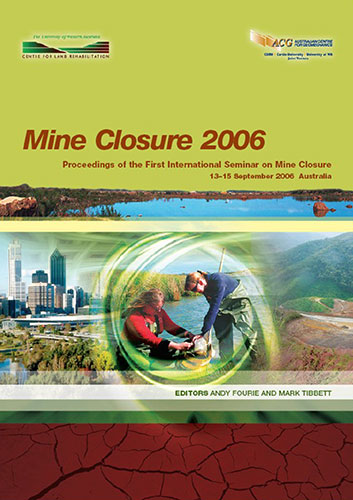Monitoring for Rehabilitation Completion and Mine Closure

|
Authors: Ward, M; Jasper, DA; Payne, C Paper is not available for download Contact Us |
DOI https://doi.org/10.36487/ACG_repo/605_66
Cite As:
Ward, M, Jasper, DA & Payne, C 2006, 'Monitoring for Rehabilitation Completion and Mine Closure', in AB Fourie & M Tibbett (eds), Mine Closure 2006: Proceedings of the First International Seminar on Mine Closure, Australian Centre for Geomechanics, Perth, pp. 751-760, https://doi.org/10.36487/ACG_repo/605_66
Abstract:
The development of a rehabilitation ecosystem is a long-term process that involves a number of complex interrelationships between physical, biological and chemical parameters. In that regard, determining the key traits of a ‘final’ or ‘climax’ ecosystem is potentially a lengthy process. In contrast, mining, rehabilitation and mine closure occur in relatively short time frames. Consequently, there can be stakeholder expectations to demonstrate ‘stability and self-sustainability’ of rehabilitated landforms, to a high standard, after relatively short periods. This is reinforced in the Department of Industry and Resource (DoIR)’s recently-released Guideline for Mining Proposals, which requires early materials characterisation and rehabilitation trials, to ensure that the aims of long term stability, visual amenity, and establishment of completion criteria, are met. For most mines in WA, the mining leases are bonded, typically leading to the objective on most sites of progressive bond release on leases where rehabilitation can demonstrate ‘stability and self-sustainability’. This creates an important role for rehabilitation monitoring to quantify the standards being achieved. The Western Australian Environmental Protection Authority (EPA) Guidance Statement 6 (2006) outlines regulatory expectations for rehabilitation, stating that: “A key aim of rehabilitation is to ensure the long-term stability of soils, landforms and hydrology required for the sustainability of sites. The second main purpose of rehabilitation is to partially or fully repair the capacity of ecosystems to provide habitats for biota and services for people.” Scientific data sets (monitoring data) should be used to validate completion criteria (EPA, 2006). These criteria that are developed to address regulatory and stakeholder expectations should be specific to the unique social, economic and environmental circumstances of the area being rehabilitated (DoIR, 2006). In summary, the tool used to assess rehabilitation should: • Provide scientifically valid, repeatable monitoring data for abiotic and biotic indices that are relevant to completion criteria. • Enable the early identification of key rehabilitation success criteria. • Be applicable to a range of environments, but provide data for specific rehabilitation ecosystems. Given the relatively short history of mine closure in WA, there are few monitoring approaches that incorporate a strategy to achieve a feasible end point in monitoring, leading to a subsequent reduction or relinquishment in bonds. The ideal monitoring tool should not only address regulatory requirements for completion criteria, but should also enable the user to review and rationalise the monitoring program to focus on the overarching aim of bond release.
References:
DoIR (2003) Environmental Branch Bond Guideline – Department of Industry and Resources, September 2003.
Department of Industry and Resources (DoIR) (2006) Guidelines for Mining Proposals in Western Australia.
Environmental Protection Authority (EPA) (2006) Guidance for the Assessment of Environmental Factors. Guidance
Statement 6: Rehabilitation of Terrestrial Ecosystems, June 2006.
Department of Primary Industries and Resources of South Australia (PIRSA) (2006) Ecosystem Function Analysis — a
tool for monitoring mine-site rehabilitation success
Tongway, D. and Hindley, N. (2003) Indicators of Ecosystem Rehabilitation Success. Stage Two – Verification of EFA
Indicators. Final report for the Australian Centre for Mining Environmental Research (ACMER).
Monitoring for Rehabilitation Completion and Mine Closure M. Ward, et al.
760 Mine Closure 2006, Perth, Australia
© Copyright 2025, Australian Centre for Geomechanics (ACG), The University of Western Australia. All rights reserved.
View copyright/legal information
Please direct any queries or error reports to repository-acg@uwa.edu.au
View copyright/legal information
Please direct any queries or error reports to repository-acg@uwa.edu.au